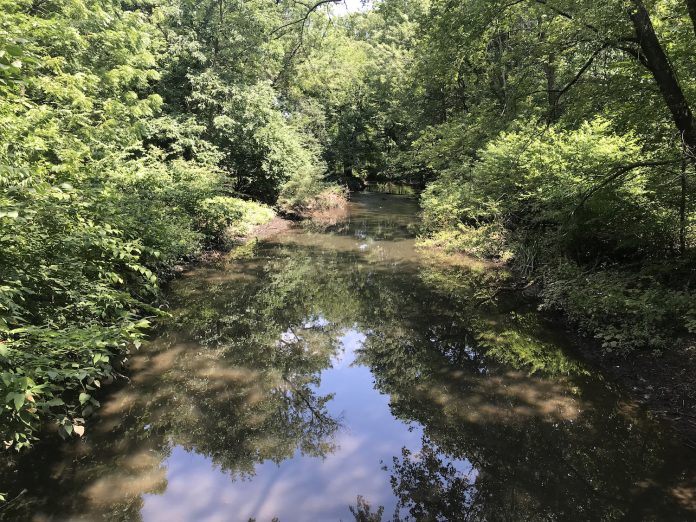“Think globally, act locally” is a phrase used for decades about protecting the environment. Today, it is urgent to consider how we can act locally, and landscaping our yards and gardens are the perfect places to start.
Sometimes, when we view the problem from a global perspective, we feel overwhelmed, depressed, and powerless. However, seated in the “Secret Garden,” a section of my backyard covered by the canopy of small trees, I see a lot of actions people can take at home. If even a third of Montclair homes would replicate this tree-shaded space, it could mean a significant increase in the number of climate-cooling bushes and trees in town. The consequence of this single collective action would be a Montclair with cleaner air and lower summer temperatures.
Here are some gardening and landscaping steps most Montclair homeowners could take in their own yards.
CREATE WILDLIFE HABITAT
Birds, butterflies, and native bees are suffering from the destruction of their favored habitats in rural areas, where overuse of pesticides and out-of-control development combine with changing climate to put them under unprecedented pressure. Suburban homeowners can throw a lifeline to these struggling species by dedicating portions of their yards to bird and pollinator gardens. Just planting a few native plants, being careful to include both host plants, such as milkweed for monarch butterfly caterpillars, and nectar plants for adult pollinators, can create an inviting space for pollinators while enhancing your yard’s beauty and vibrancy. Supplement this landscaping with attractive berry-producing native bushes and trees, like cranberry bush viburnum, flowering dogwoods, and service berry, and you will provide natural food sources and nesting sites for birds. You could eventually save money on bird feeders and birdseed since birds will find abundant free food in your yard.
USE NATIVE PLANTS
I never stop praising the use of native plants and encouraging people to include them in their landscaping. Native plants have an immediate beneficial impact on the environment. They are adapted to the weather conditions of our region and have co-evolved with our local birds and insects in a harmonious balance. Many are also drought tolerant and, once established, do not need to be watered, conserving water for other uses as climate challenges grow.
SAVE WATER
As climate change creates more droughts and uneven rainfall, gardeners should look at other approaches to conserving water. Collecting rainwater in barrels is another way to save this precious resource while mitigating the effects of the sudden heavy downpours that have become more common. The township sells rain barrels to Montclair residents at discounted prices, so what’s holding you back?

Clark’s Pond Nature Preserve in Bloomfield. JOSE GERMAN/FOR MONTCLAIR LOCAL
REDUCE WASTE
Rather than throwing out kitchen waste, such as fruit and vegetable peels, coffee grounds, and tea bags, as well as leaves and clippings from your garden, use them for compost. Home composting reduces the carbon dioxide released from transporting these materials to the incinerator and then burning them. It may have the added benefit of temporarily sequestering carbon in your soil. Fortunately, the township of Montclair sells compost bins at a discounted price for residents. I recommend getting a minimum of two.
LANDSCAPE TO SAVE ENERGY
Thoughtful landscaping is one of the most effective ways to reduce your carbon footprint and save money on energy bills. Planting deciduous trees on the south and west sides of your home keeps your house cooler in the summer by providing shade, while letting the warming sun in during the winter months when the trees lose their foliage. Meanwhile, planting evergreen trees or tall shrubs on the north side of your house creates a barrier to winter winds, reducing the cost and climate impact of heating your house. Trees also provide the essential benefits of sequestering carbon and creating cooling shade, so the more the better. Caring for often-neglected newly planted street trees is another way to make a contribution.
REDUCE FOSSIL-FUEL USE
Reduce the use of power equipment, like gas mowers and leaf blowers, in yard maintenance. If your yard is not too big, a traditional push mower has zero carbon emissions, while raking leaves is an easy, cheap, carbon-neutral (and quiet!) alternative to noisy, polluting leaf blowers. Mowing only when needed can reduce the use of a power mower while saving you time and energy; mowing roughly every 10 days in spring and bi-weekly during the summer is usually enough.
GROW YOUR OWN FOOD
Planting a vegetable garden is rewarding in its own right, providing fresh food and gentle exercise, but it is also a step toward reducing carbon emissions. Supermarket vegetables have usually traveled hundreds or even thousands of miles. Think of the carbon cost of transporting them such distances! The only transportation involved in bringing veggies from your garden to your kitchen will be the carbon-free steps you take from your door to your garden and back.
Finally, although your gardening practices can help fight climate change and its effects, a problem on this scale requires more than individual action. You can increase your impact by motivating your neighbors to do the same, and whether or not you have a yard you can get involved with local environmental groups working on climate-related projects. Most important, let your representatives at the local, state, and federal level know this is a decisive issue for you.
If you feel overwhelmed about climate change or think you are not doing enough, try some of these recommendations. Remember, acting locally for a more sustainable world is the best you can do to preserve the planet. Our children deserve a better future.
